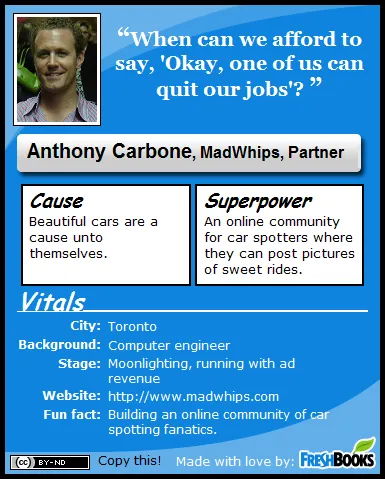 Sudbury, Ontario based ConceptShare is one of the best examples of a fast growing, healthy and original startup in Canada. They have gone from idea, to execution and now to business development in a short period of time. They have done it all from Sudbury.
Sudbury, Ontario based ConceptShare is one of the best examples of a fast growing, healthy and original startup in Canada. They have gone from idea, to execution and now to business development in a short period of time. They have done it all from Sudbury.
The idea was simple enough. You have any sort of artwork or video, and you need to bring in other people to help edit and refine your work. The old way of doing things was to email your files around and have people open them locally on their PC. With Conceptshare, your co-workers, partners and others can simply log in and see what you are working on, and they can offer their own suggestions right there on the spot. Collaborators can draw right on the screen, they can make notes and leave messages for eachother.
I won’t go any further in to just what Conceptshare does, because their name is descriptive enough and their website is even more helpful. They also have one of the best demo movies of any startup out there.
Differentiating in a muddled market
“Collaboration” is not a new idea. The market for collaboration tools is endless and highly competitive. Instead of jumping in to that big, endless fight, ConceptShare worked hard to focus on a basic set of needs for what was initially a very defined market (graphic designers). By doing things right and in a smaller puddle, ConceptShare turned in to the perfect tool for a lot of things. They now have customers doing almost every sort of collaboration you can imagine, and they are just getting started at going after these new markets.
ConceptShare also made one critical smart move up front. They didn’t try to do real-time collaboration. That would have included real-time audio chat, video chat and all sorts of extras that most customers don’t really want. Instead, they built their tool around how people really work: asynchronously. If you want me to review a document, or new graphic design, I don’t want to have to meet you online at a certain time to discuss it: I would rather just pop in and make notes when I have the time.
A critical mistake that competing companies have made, in my view, is that they focused on real-time. Real-time requires a change in the user’s behavior, and trying to change behavior rather than compliment it is almost always a road to failure.
Staying Focused
Bernie, Scott and Chris have spent the last year and a half working on ConceptShare with incredible focus. Right from the beginning, when they were running around the first Mesh conference with their laptops, doing demos for potential investors, they have been role models of how to just do it when it comes to starting your own company. While a lot of would-be entrepenurs will wonder “should I do this”, etc.
An Angel Round, and on to VC
To really get off the ground, Conceptshare raised an undisclosed amount of Angel funding. The fact that they were able to get their funding in place so early is a testament not just to their great idea, but the hard work these guys continue to put in.
The guys are now hitting the road to raise a round of Venture Capital. The decision to go down this road was not an easy choice for them to make. They tell me that they are more concerned with finding the right kind of VC than they are with just taking money from anyone. They are looking for a partner to help them grow the business.
Overall, I think it is a smart move for a company in their position. They are arguably the market leaders in a space that is only just starting to come in to itself. I would be surprised if Scott, Bernie and Chris didn’t have their pick of VCs, as well as some pretty favorable terms. Let’s cross our fingers that they don’t end up having to go south like StumbleUpon, iUpload (now Awarness), or flickr.
And now…
This week ConceptShare has doubled it’s workforce and has brought on Will Pate to help drive the company ahead. Will is an experienced community builder and will be doing that, and I suspect other work, with ConceptShare. Hiring smart is critical and Scott, Bernie and Chris have been careful about who they bring on.
So what else is next? A search shows that they own the domain conceptnation.com, which looks like a preview of some sort of new crowd-based marketplace or network. So, I am guessing that it won’t be long before the guys have big announcements coming out left and right.
Contact: Scott Brooks
 Meet Frances Fast of Q1 Capital. She specializes in getting startups funded… fast. There is such a thing as a startup investment banker. Frances recently joined Q1, to lead their Private Investor Network, but she is not new to the industry; Frances has been working with angel groups in Canada for nearly a decade, talk about a golden Rolodex.
Meet Frances Fast of Q1 Capital. She specializes in getting startups funded… fast. There is such a thing as a startup investment banker. Frances recently joined Q1, to lead their Private Investor Network, but she is not new to the industry; Frances has been working with angel groups in Canada for nearly a decade, talk about a golden Rolodex.




 Here is where their story takes a turn for the better however. Just when we all thought that Savvica was done for, John and Malgosia did the smart thing. They didn’t “go out of business”, or take down the site. They didn’t declare it a failure and start preaching about all the lessons they learned. Instead, they kept burning a little midnight oil, still looking for a deal or an opportunity, and most of all, they kept their dream alive.
Here is where their story takes a turn for the better however. Just when we all thought that Savvica was done for, John and Malgosia did the smart thing. They didn’t “go out of business”, or take down the site. They didn’t declare it a failure and start preaching about all the lessons they learned. Instead, they kept burning a little midnight oil, still looking for a deal or an opportunity, and most of all, they kept their dream alive. What happens when you’ve made a business out of publishing
What happens when you’ve made a business out of publishing  Sudbury, Ontario based
Sudbury, Ontario based 

